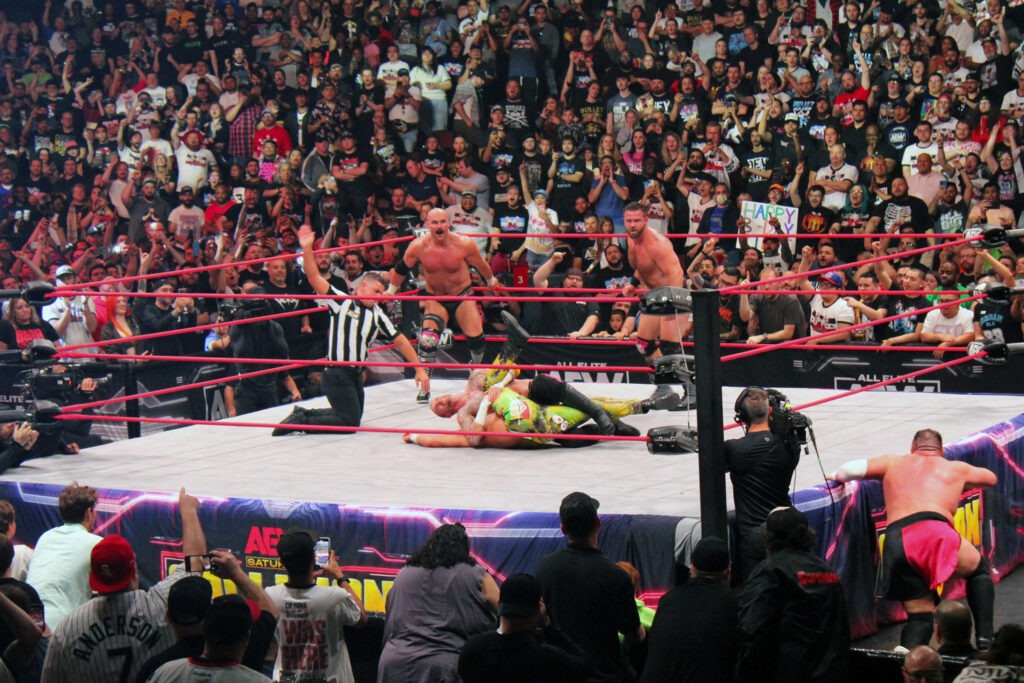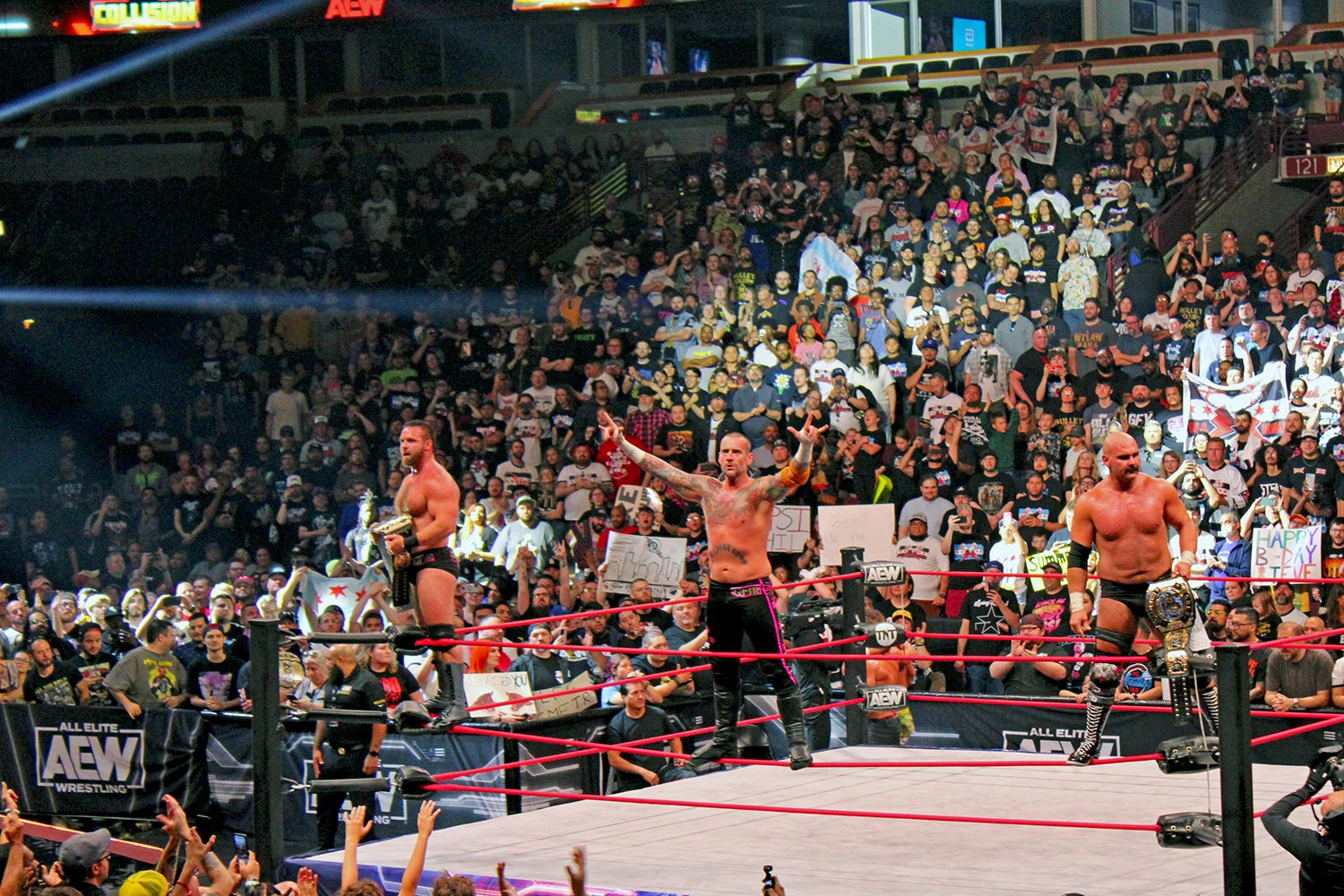A quiet tension gripped the United Center the moment the lights dimmed Saturday night. While beer and popcorn were plentiful, and the opening matches were entertaining, only one man could satiate the real appetite wrestling fans built up over the last nine months — and that man delivered.
As the lights roared back to life, Living Colour’s “Cult of Personality” bellowed out as the crowd responded to the tune with cheers of their own. In walked the main attraction, CM Punk, with wrestling boots around his neck and a red sack in hand that contained the championship title belt he never lost.
After a slow saunter to the ring, we heard his first words spoken to a crowd in nine months: “I don’t know if you guys heard,” Punk said. “But I’m tired of being nice.”
With that phrase, Punk jump started the heartbeat of All Elite Wrestling’s newest program, Collision. After a vicious promo that heavily alluded to his unresolved issues with AEW Executive Vice Presidents Nick and Matt Jackson, together known as the Young Bucks, Punk cemented the fact that he doesn’t plan on changing his ways any time soon. Classic Punk had returned.
Ask the average wrestling fan how they feel about CM Punk, and you’ll get a response that boils down to one of two answers: “He’s the Greatest Problem” or “He’s the Best Solution.”
That’s because Phillip “CM Punk” Brooks will always be himself. And nothing solidified that fact like his era-defining feud with WWE superstar John Cena and WWE Executive Chairman Vince McMahon in 2011. Considered one of the best storytellers in modern wrestling, his skill with a microphone made him stand out more than his in-ring ability (although that’s also quite the performance).
The 44-year-old Chicago native was originally popularized by his “straight edge” character, as he proudly disavows and refrains from participating in drugs, alcohol, and foreign substances. That’s not just an act for the fans, either. For his entire life, he’s always been straight edge. And his teetotaling philosophy in and out of the ring also serves as an example of one of the key components of CM Punk’s success with his character: consistency. Throughout the seven years outside of the industry — from his dramatic exit in 2014 up to his grand return after signing with AEW in 2021 — Punk has not compromised his views, for better or worse.
The debut of AEW’s new televised program, Collision, was blanketed in an air of uncertainty. The new show promised a more focused approach to storytelling in comparison to its sister programs Dynamite and Rampage. There were also some in-ring returns planned that fans have been clamoring for, such as “The Redeemer” Miro and Andrade El Idolo. While there was a palpable excitement for the new program to rally the declining wrestling promotion, the selling point of the show was the return of Punk.
It would be the first time the world has seen him since a violent backstage (off-camera) altercation last September. Following a pay-per-view All Out show, the fight involved Punk, with his close friend and trainer Ace Steel, against the Young Bucks and fellow AEW Executive Vice President Kenny Omega. Omega and the Young Bucks, together known as “The Elite,” were heavily involved in the creation of AEW — making it feel like part of the company had turned against Punk.
Then came the uncertainty. The incident led to suspensions for all involved. During an earlier match the same day, Punk tore his left triceps tendon off the bone. Plus an out-of-control post-show press conference saw Punk accusing The Elite of spreading rumors about him to the wrestling media. All parties would have to be out of action for an undetermined amount of time while their reputations and bodies healed.
After the All Out incident, it seemed the general sentiment about Punk’s return in 2021 shifted from breath-abated excitement to complete exasperation. The fanbase quickly chose sides, fragmenting the AEW audience into those who saw Punk’s unprofessionalism as an overall detriment to the company, versus those who thought Punk’s grievances with the professionalism of AEW’s leadership had some merit.
While waiting to enter the United Center, fan Roy Banks voiced an overall excitement to see his first AEW show. “I was initially against Punk after the All Out incident,” Banks says, “then The Elite taunted him and I didn’t appreciate that.” After The Elite returned to television about two months after the incident, fans found it odd that the usually outspoken Punk was now radio silent. He would continue to be for the next nine months, fueling rumors about his behind-the-scenes likeability and possible dismissal from the company.

Then an ESPN interview with Punk came out a day before the debut of Collision. Punk acknowledged his wrongdoing at the All Out media scrum, while suggesting that his relationship with The Elite wasn’t quite mended. Maybe he was truly remorseful — or maybe he’d be coming back with a vengeance.
Whatever the case, thousands of Punk fans and cynics wrapped around the United Center in uniform lines to find out. Did he hold a grudge? Is he truly willing to forget and forgive?
Would any of these questions even matter?
Despite the polarizing effect of the All Out kerfuffle, some Elite fans were still on board for Punk’s return for the entertainment value, which is crucial to keep the company afloat. “I’m more of a Kenny Omega and The Elite kind of guy,” fan Mike Pixley said, waiting outside the gates. “But I realize that [Punk] brings a lot of attention to AEW.”
Later in the night, fighting alongside his friends Dax Harwood and Cash Wheeler (the duo also known as FTR), Punk closed with a victory over Samoa Joe, Jay White, and Juice Robinson in a six-man tag team. Between Punk’s return and the rest of the night’s matches and entertainment, attendants considered Collision’s debut to be a success.
That said, a strong return to the ring in Chicago does not mean that a generally positive reception will be universal for Punk. He may have received a hometown hero’s welcome at the United Center, but fan sentiment is almost guaranteed to be less warm in other cities.
It’s ultimately a risk to use Punk as the face of Collision. His immense popularity, seniority, and skill with a mic make him an obvious choice for main-eventer. But his hot-headedness could lead to friction with members of the company. It’s possible that Punk hasn’t learned his lesson, but as far as spicing up their wrestling programing, it seems AEW may have also found both a problem and solution.



